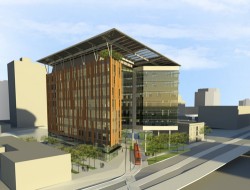The materialization of the Oregon Sustainability Center, what would be the nation’s first “living building,” hit a wall last month when the Oregon Legislature denied essential state bonds to help finance it. However, the team leading the project hasn’t lost hope of seeing it come to life.
Growth stunted for nation’s first ‘living building’
The materialization of the Oregon Sustainability Center, what would be the nation’s first “living building,” hit a wall last month when the Oregon Legislature denied essential state bonds to help finance it. However, the team leading the project hasn’t lost hope of seeing it come to life.

But in the face of continued funding issues, the disappearance of key project partners and changing leadership, the project’s future seems up in the air. Failing to gain state funding is a major setback for the center, but proponents at Portland State remain focused on meeting the demands of the university’s expanding student body and needs.
The proposed building, to be at the corner of Southwest Montgomery Street and Fourth Avenue, may not come to fruition, but according to PSU Director of Communications Scott Gallagher, the university is still looking to find ways to increase classroom space and build on the university’s reputation as a key player in the field of sustainability.
“PSU’s needs have not changed,” Gallagher said. “We still desperately need large classroom space that’s on campus to accommodate for our growth, we still need to find ways to expand our research opportunities especially in the area of sustainability…so whether it’s this project, or another project, or another couple of projects, we’re still committed to working with the city and with Portland Development Commission to find solutions for that,” Gallagher added.
Projected to cost almost $62 million, the center’s realization was contingent on receiving $36 million in state bonds. Another $3 million was to be granted by the Oregon University System, an initial key partner in the project, but following the legislature’s unfavorable decision, OUS decided to back out of the project.
“Moving to 2013, there are going to be other priorities, and the Sustainability Center is not on the list,” State Board of Higher Education member Jim Francesconi told The Oregonian last week.
Despite the loss of funding from the state and OUS, the Sustainability Center’s project members remain optimistic. According to Mark Gregory, PSU associate vice president of finance and administration, the university will continue to look for ways to fund the center. “The city and PSU are considering other ways of funding that project or a similar building,” Gregory said.
“PSU remains deeply com-mitted to being a living laboratory for sustainability initiatives and continues to need the sustainability research, faculty office and classroom spaces that the building would have brought to PSU,” Gregory said. “So we remain interested in finding a way to meet those needs. Any solution will need to be cost effective and sensible for PSU in the current budget climate, and not having state financing in the mix makes that more challenging.”
One possible solution is to find private investors, but some proponents of the Sustainability Center believe that relying on private investment would add further costs to an already costly project. In an August 2011 Budget Note Response to the Joint Ways and Means Committee, Jay Kenton, vice chancellor of finance and administration for the OUS, said that outside funding brought additional risk to the project.
“Most other forms of non-public financing would exacerbate already high rents, as public financing carries a much lower rate of interest,” Kenton wrote in an email. “The team has explored multiple options to finance this project, including private bank financing, use of Federal EB-5 funding mechanisms, low-interest federal grants, loans and other public and private funding mechanisms. In all cases, these alternative scenarios increased costs to the participants, project complexity and risks,” Kenton added.
Despite the numerous setbacks, Shawn Uhlman, a spokesman for the Portland Development Commission, maintained what seems to be the general consensus: hope for future options.
“The project team is really continuing the process of evaluating what the options are for private sector funding, so what that would look like and what amounts and the timing is still something the team is still working on,” Uhlman said. “The project team is going to continue to look at what options are available in the private sector and what we can do to work to move the Oregon Sustainability Center forward.”
Johanna Brickman, sustainable built environment program manager for the Oregon Built Environment and Sustainable Technologies Center, a partner in the OSC, echoed the same sentiment of optimism for the future in a blog post for Metropolis Magazine.
“I still hold out hope for the OSC because the project continues to enjoy a broad base of support and the project team is committed to working in partnership toward the construction of the OSC…In the event that this particular living building is not built, our ability to pursue all 11 of the OSC’s research projects in a single building may be at risk; but I wouldn’t discount it.”
The current vision of the sustainability center may not come to life, but its proponents remain optimistic that the project will bear fruit of some kind.
“We’re talking about big projects with a lot of people involved, and with a lot of money, and a lot of needs, and that’s not easy to put together quickly,” Gallagher said. “And so we had one particular proposal, and that proposal didn’t work in regards to getting funding from the state. You have to step back and reevaluate, look at all of the options, and that’s what we’re doing.”






Wow, what a big chunk has been denied from the state. At this point, it looks like things will get delayed immensely. It is such a shame, since the sustainability efforts in Oregon, especially in Portland State, are something I take great pride on, and this center would represent it.